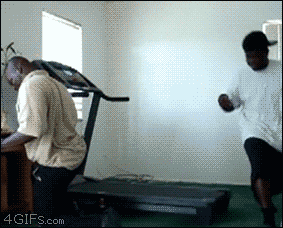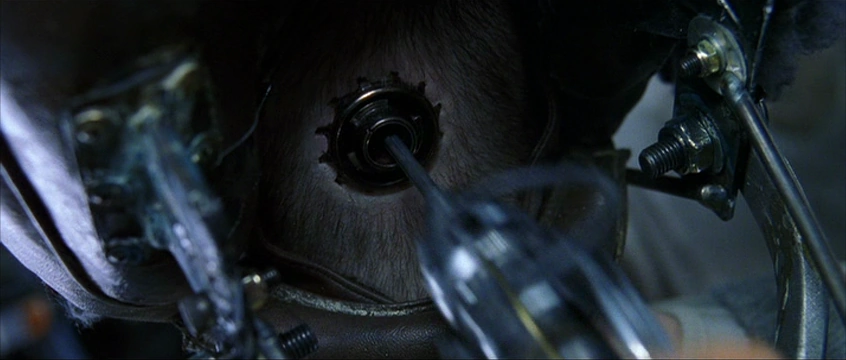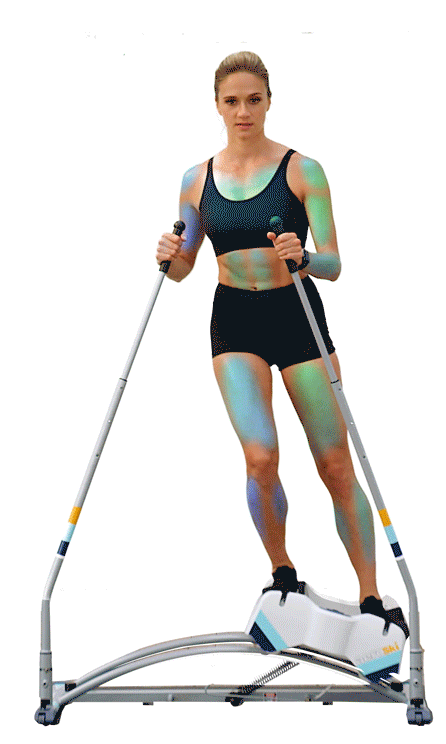Another omnidirectional treadmill has been making the rounds this week. This one from Disney looks very cool, with a creative mechanism for moving the feet around that has a lot of advantages.
Unfortunately, the real issues with omnidirectional treadmills can't be solved by changing what happens at the feet, because the problem is all in your head. Specifically in your inner ear; your vestibular system. And this problem is unavoidable because it is rooted in the way we walk and ultimately in the laws of physics. So what exactly is the problem? And why does the idea keep getting traction regardless?
But they do work, right? I can see it working!
Omnidirectional treadmills can "work" in the sense that they can successfully shift your feet in any desired direction. They don't work in the sense that they don't achieve what people really want and expect them to do. I myself have used a prototype of the "treadmill made of treadmills" variety. An immense, imposing engineering achievement. It must have cost a fortune and was quite loud, but it sure did move feet around very effectively. It was even featured in the Ready Player One movie.
Unfortunately, "moving feet around" isn't enough to achieve what people really want. That is, the ability to naturally walk, run, and jump in any direction. Just as headphones can cause your brain to perceive any possible sound, and a VR headset can cause your brain to perceive any possible visual scene, an omnidirectional treadmill should trick your brain into perceiving movement in any direction, while in reality you remain close to the middle of the treadmill. Can they really achieve this?
Gym treadmills work... But!
Gym treadmills are the reason why people think omnidirectional treadmills are a good idea. After all, I can run just fine for miles on the treadmill at the gym while remaining stationary, right? If I close my eyes (and I have a fan in front of me) it feels exactly the same as running outside. My body can't tell the difference between going 10 MPH and 0 MPH. So we're done, right? A treadmill made of treadmills should allow me to go 10 MPH in any direction without moving in reality, and my brain can't tell the difference!
To see where the problem lies, we have to understand the vestibular system. Your sense of balance comes from the vestibular system located in your inner ear. It is absolutely critical to your ability to stand and walk. If it malfunctions you will hit the floor very quickly, as vertigo sufferers well know. You may be aware that your cell phone contains a gyroscope that detects 3-axis rotation and an accelerometer that detects 3-axis linear acceleration. The vestibular system is your equivalent set of sensors located in your inner ears. The gyroscope part doesn't cause problems for treadmills. It's the accelerometer part that is the issue.
An accelerometer of course measures acceleration, that is, changes in velocity, not velocity itself. This means it can't tell whether you're going 10 MPH or 0 MPH. So far so good; the gym treadmill really does work! However, if you are going 10 MPH and you change direction, that is a change in your velocity that your vestibular system can detect. If your brain thinks you're running at 10 MPH in one direction but in reality you are going 0 MPH on a treadmill, your velocity doesn't change when you turn, your brain doesn't get the acceleration signal it expects, and things feel very wrong. You may even fall over.
Even the gym treadmill is not perfect. When you change speed your brain expects an acceleration that isn't there. So you will notice an unrealistic feeling as you change the speed on a gym treadmill. For this reason gym treadmills change their speed slowly. Abrupt changes in speed may cause you to fall.

Fortunately for the gym, you spend most of your time on the treadmill going at a constant speed in a perfectly straight line. Speed changes are gradual. Unfortunately for omnidirectional treadmills, in real life people spend very little time going in perfectly straight lines at constant speed. People playing action games will need to change speed and direction constantly. They will need to turn while walking or running, and stop or reverse direction abruptly. All of these motions will feel completely unnatural and may even cause the user to fall.
What if we add a harness?
Most omnidirectional treadmills indeed use a harness that stops you from falling over due to this issue. But this necessarily restricts your movement, and doesn't do anything to make the walking itself feel more natural. As you might imagine, having your weight borne by a harness doesn't feel like natural walking.
What if we make it really big?
Making the treadmill bigger would help. You could start out walking perfectly normally, and only run the treadmill slowly when necessary to nudge you back to the center. I don't really think this is practical for a couple of reasons.
One, your vestibular system is sensitive and will still be disturbed unless the treadmill's acceleration is very small. But very small accelerations will take a long time to re-center you. A person would be able to go a long way during that time, meaning the treadmill would have to be positively enormous. Larger than a typical house if you wanted to allow running.
Two, these things are full of moving parts which need to be quite powerful. Even a small one is very expensive, somewhat dangerous, and likely to need a lot of maintenance. A house-scale treadmill would be ungodly expensive and constantly broken. If you had enough space and money for it, you'd be better off spending that money designing a VR experience to fit in that space without a treadmill at all. Then you wouldn't be restricted to completely flat open spaces without walls or physical props, either. And there are many other VR techniques that are already in use to create the illusion of more physical space than you actually have, such as fake elevators, portals, and redirected walking.
Galvanic Vestibular Stimulation to the rescue?
"Hey!", I hear you say. "I once heard about a device that controls your sense of balance by running an electric current through your head! Maybe we can control the vestibular system to fix the issue!" Yes, Galvanic Vestibular Stimulation is a real thing, and yes, it involves sending electric current through your head. To my knowledge, the control that it provides over the vestibular system is crude and imprecise. But even if it offered perfect control, you are essentially giving yourself vertigo on purpose. Maybe OK if you are lying down, but if you are standing and walking, as we would like to be able to do on an omnidirectional treadmill, it will cause you to lose your balance and fall over. You can't fool physics.
Also, the vestibular system is not the only sense affected by acceleration. The movement of your limbs and even your internal organs also give acceleration cues to the brain. And if they don't match what the vestibular system is reporting, motion sickness may result.
To fix all these problems we'll have to go even farther, controlling not just your vestibular sense but your proprioception and whatever senses you have internally to your body. Basically we'll need to override everything with a "The Matrix"-style brain jack. At this point, we won't need a treadmill anymore.

Omnidirectional treadmill as niche exercise machine
So we have to give up on the Holodeck dream for omnidirectional treadmills. They can't simulate omnidirectional movement in a way that feels natural, and this isn't fixable. But maybe that's OK. Maybe we can still use them unnaturally. If you train yourself, maybe you can learn to do the strange movements that are required to change speed and direction on the treadmill. Certainly there are plenty of niche exercise machines that have you doing motions that kind of simulate real activities but not very well.

Maybe there's a market for this. But it's a far cry from the Holodeck dream that people selling omnidirectional treadmills want you to imagine.